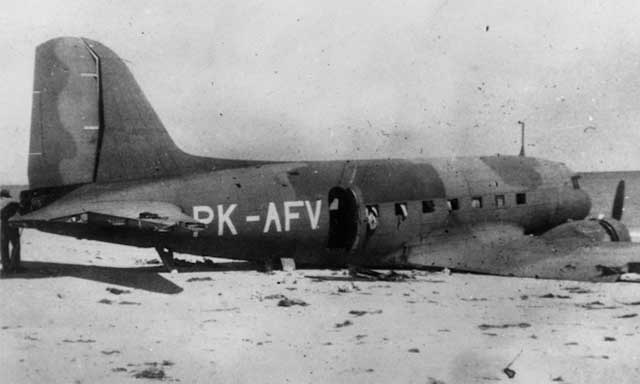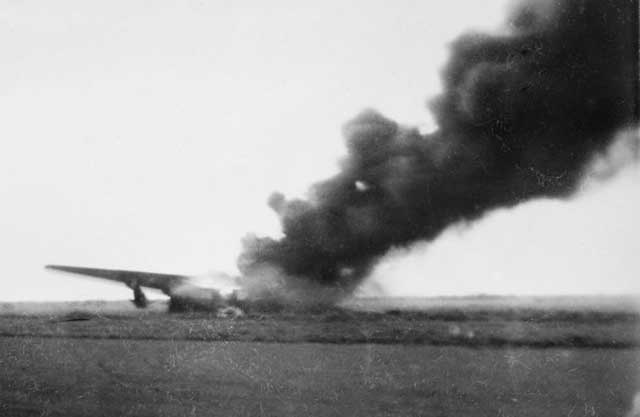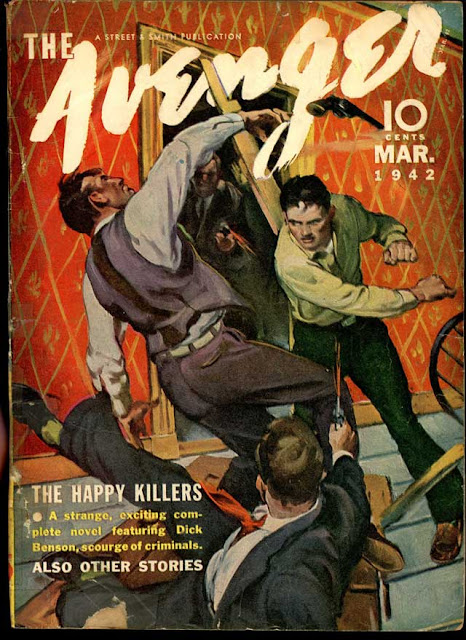Tuesday 3 March 1942
 |
| A B-17 Flying Fortress destroyed on the ground during the 3 March 1942 Japanese air raid on Broome, Western Australia. |
Battle of the Pacific: Japanese planes bomb the town of Broome, Western Australia, on
3 March 1942. The raid, carried out by nine Mitsubishi A6M2 Zero fighters and a Mitsubishi C5M2 reconnaissance plane from their base at Kupang, Timor, kills 88 people. Broome is not a large town but is a key refueling point for aircraft traveling from the Netherlands East Indies (Indonesia) to other destinations in Western Australia. There also is a large group of refugees from the East Indies and some military personnel staying at Broome. The surprise raid destroys eight PBY Catalinas operated by the Royal Australian Air Force, the Royal Netherlands Navy Air Service (MLD), United States Navy and the Royal Air Force; two Short Empires belonging to the RAAF and QANTAS, and five Dornier Do 24s belonging to the MLD. A total of 24 Allied aircraft are lost. The Japanese also shoot down a USAAF B-24 about 16 km (10 miles) offshore, killing 19 of 20 US servicemen on board (one man manages to swim to shore). There is little opposition to the raiders because there are no Allied fighter planes based there, but ground fire downs a Zero, killing the pilot, and another Zero runs out of fuel and has to ditch on the way back to base.
 |
| This is the DC-3 shot down north of Broome on 3 March 1942 in which a cache of diamonds mysteriously disappeared. |
While returning to Timor from Broome, the Japanese shoot down KNILM (requisitioned from KLM) Douglas DC-3-194 PK-AFV "Pelikaan." It is on a flight from Bandung, Dutch East Indies (later Indonesia), to Broome. The plane crashes at Carnot Bay, about 50 miles (80 km) north of Broome. Japanese ace Lt Zenjiro Miyano and two other Zero pilots attack the airliner from above, destroying the port engine and forcing the plane to land successfully on the beach. The Zeros then strafe the plane, killing the engineer and three passengers. The next day, a Japanese Kawanishi H6K flying boat attempts to bomb the plane but misses. The survivors are rescued after spending six days on the beach. There is an element of mystery surrounding this incident because a valuable shipment of diamonds on board the plane is never found - well, except for a fraction of them. A beachcomber later turns in 10% of them (valued at A$20,447) and is accused of stealing the rest, but is acquitted in 1943.
 |
| USS Asheville, sunk on 3 March 1942. |
Japanese patrols south of Java continue finding and sinking Allied ships fleeing the island. Japanese destroyers Arashi and Nowaki, under the command of Vice-Admiral Nobutake Kondō, use their guns to destroy US Navy gunboat USS Asheville during the early afternoon about 200 miles east of Christmas Island. There is only one survivor, 18-year-old Fireman 1st Class Fred L. Brown, who tells his story about the ship's final battle to another POW before passing away on 18 March 1945 in the Japanese Makassar prisoner-of-war camp in the Celebes Islands of the Netherlands East Indies. Japanese warships also sink 3472-ton British freighter HMS Anking in the same area (16 survivors). After these battles, many Japanese forces retire from the area.
 |
| Another view of the DC-3 "diamond plane" shot down north of Broome, Australia on 3 March 1942. |
On Java, the Japanese begin expanding out of their landing zones. Late in the day, Blackforce, a multination scratch force under the command of Brigadier Arthur Blackburn V.C., abandons its attempt to contain the Japanese invasion forces at Leuwiliang in West Java and withdraws toward Soekabumi. The Japanese head west and take Madja (Maja) and Balaradja (Balaraja). The Japanese 3rd Air Brigade arrives at Kalidjati airfield.
 |
| Australian soldiers examine the wreckage of the DC-3 "diamond plane" shot down north of Broome, Australia on 3 March 1942. |
In Burma, Japanese forces have been infiltrating through the jungles past Allied positions blocking the main roads. Today marks the beginning of the Battle of Pegu. Japanese forces attack a motley collection of Allied troops around the main blocking position at Pegu from the northeast in the Waw-Pyinbon area. The Allied forces prepare to counterattack, moving forward a large force of M3 Stuart light tanks (nicknamed "Honeys" by the British and Commonwealth militaries). During this battle, which lasts about a week, the Honeys first destroy two Type 95 Ha-Go Japanese tanks. The battle continues for some time after that, with the Japanese losing three more tanks. Emboldened, the British tanks advance to Hiegu, where they run into a larger Japanese tank force, lose a Honey, and are forced to retreat. The British tanks then begin withdrawing past Rangoon to Prome, about 200 miles further north. This begins a general withdrawal and makes inevitable the loss of Rangoon, but today the British 63rd Brigade Group arrives there as a show of strength (with no actual intention to defend the capital against the overwhelming Japanese strength).
 |
| "Broome, [Western Australia], 3 March 1942. The remains of one of eight large aircraft, which included two Flying Fortresses and two Liberators, destroyed on the aerodrome in the Japanese air-raid on the town. Sixteen flying-boats in the harbor were also destroyed. Most of the aircraft had just arrived from the Netherlands East Indies carrying refugees who were still aboard them. It is estimated that seventy people, including women and children, were killed, and probably as many again wounded in the raid." Australian War Memorial 042696. |
US Navy submarine USS Perch (David Hunt) is scuttled northwest of Surabaya after suffering damage from enemy destroyers during the last two days. All 54 men go into Japanese captivity (six perish as POWs from malnutrition). Other Allied ships continue to be scuttled rather than be captured by the Japanese, including 1018-ton Dutch freighter Bintoehan and 3027-ton Duch freighter Van Neck. Japanese bombers sink 4068-ton Australian freighter Koolama off Wyndham, Cape Londonderry, Australia.
Japanese submarine I-1, operating south of Tjilatjap, uses gunfire to sink 8667-ton Dutch freighter Siantar. There are 37 survivors and 21 deaths.
US Navy Task Force 16 (Rear Admiral Halsey) is en route to attack Marcus Island when its patrol planes report spotting and attacking two Japanese submarines. Halsey proceeds with the mission.
The RAAF sends five Hudson bombers from 7 Mile Drome (Jackson Airport, Papua New Guinea) to attack Japanese positions at Gasmata on the southern coast of New Britain. They lose two planes.
Two Japanese Kawanishi H8K flying boats take off from Wotje Atoll in the Marshall Islands and fly to the French Frigate Shoals about 560 miles northwest of Honolulu. They refuel there from two waiting submarines. They then take off on a mission to bomb Oahu, Hawaii, which is to take place early on 4 March.
 |
| A view of destroyed bombers at the Broome airfield on 3 March 1942 after the Japanese air raid. |
Eastern Front: Accepting defeat in his attempt to break the Axis defenses on the Parpach Narrows of the Crimea, Lieutenant General Dmitry Timofeyevich Kozlov, commander of the Crimean Front, calls off his offensive. His forces have been battered, losing 27 KV-1 tanks while accomplishing little. The one Soviet success is a bulge in the line at the extreme northern section of the front. Stalin is unhappy and orders Kozlov to attack again within ten days. There are recriminations within the Soviet high command. This leads to the firing of Transcaucasian Front's chief of staff General-Major Fyodor Tolbukhin, whose attack plans are deemed faulty for failing to account for mud caused by warm weather and for being too complicated for the troops' abilities.
 |
| "A pall of smoke rises from the burning hull probably of a Liberator, one of the six large aircraft, which included two Flying Fortresses and a Liberator, destroyed on the aerodrome in the Japanese air-raid on the town on 3rd March 1942. Most of these aircraft had just arrived from the Netherlands East Indies carrying refugees who were still aboard them. It is estimated that 35 to 40 people were killed, including women and children, and probably as many again wounded in the raid. Fourteen flying boats in the harbor were also destroyed." Australian War Memorial P02039.003. |
European Air Operations: RAF Bomber Command has spent the last three nights resting up but returns to action with a full-scale raid on the night of 3 March 1942. It sends 235 aircraft (89 Wellingtons, 48 Hampdens, 29 Stirlings, 26 Manchesters, 23 Whitleys, and 20 Halifaxes) against the Billancourt (Paris) Renault factory. The bombers attack in three waves over the course of an hour and 50 minutes, with flares marking the target (though there is no dedicated pathfinder force at this time). A total of 223 aircraft crews report bombing the target at a loss of only 1 Wellington. This is the largest RAF raid against a single target of the war (the previous high was a raid on the night of 7 April 1941 against Kiel). About 450 tons of bombs are dropped. French sources report that 40% of factory buildings are destroyed, halting production for four weeks. There are 367 French civilian casualties.
There also are small RAF operations of four Wellingtons to Emden (one lost), four Blenheims bombing Dutch airfields (recalled), four Lancasters laying mines off the northwest German coast, and two Whitleys dropping leaflets over France. After tonight's major effort, RAF Bomber Command goes on another hiatus until 7 March.
 |
| A Stinson aircraft later bombed on the ground in Broome, 3 March 1942. IMAGE CREDIT: State Library of Queensland. |
Battle of the Atlantic: U-129 (Kptlt. Asmus Nicolai Clausen), on its fourth patrol out of Lorient, torpedoes independent 5104-ton US freighter Mary at 17:05 about 165 miles north of Brazil. Hit by two torpedoes within a matter of seconds, and then two more 15 minutes later, Mary, which is carrying war stores, sinks around 17:30. The crew has time to take to the boats and there is only one death, caused by the initial torpedo strike. There are 33 survivors.
Royal Navy motor torpedo boats sink 3493-ton German freighter Abbeville off Cap Blanc Nez, France.
 |
| SS Mary, scuttled by her crew at Surabaya, Java on 3 Mary 1942. |
Battle of the Mediterranean: Axis aircraft stage continuous raids on Malta beginning at 09:35 and continuing until 12:57, then from 14:19 to 15:25, with intermittent raids continuing for the rest of the day. The "All Clear" finally sounds at 18:50, but another raid begins at 19:37 and lasts for eleven hours throughout the night. There is damage all across the island, including to Royal Navy submarine HMS Upright. Adding to the chaos is the arrival of eight Wellington bombers from Gibraltar and several other planes from other stations.
South of the Kassandra peninsula, HMS Turbulent (Cdr. J.W. Linton) uses its deck gun to sinks Greek caique Agios Dionyssios (KAL-199). The Germans use these caiques for troop movements to and from the Aegean Islands. Sixteen German troops on the caique perish.
 |
| "The burnt-out remains of what was probably a Royal Netherlands East Indies Air Force DC-3 destroyed on the ground in the Japanese air-raid on the town on 3 March 1942." Australian War Memorial P02039.001. |
Allied Relations: The Combined Chiefs of Staff begin considering a new proposal for the invasion of North Africa late in 1942. This has codename Operation Supergymnast. It replaces Operation Gymnast, which the USAAF Eighth Air Force believes would divert too many resources from the bombing campaign against Occupied Europe and Germany. The Supergymnast plan would include combined invasions by British and United States forces at Dakar, Casablanca, and Tunisia. This is a predecessor of Operation Torch, carried out in November 1942.
Chinese/British Relations: Chinese Nationalist leader Chiang Kai-shek meets with local British commander General Archibald Wavell in Burma. Chiang has promised the use of Chinese troops to help defend Burma.
 |
| SS Abbeville (Seen here when she was the Chickahominy SS), sunk by British MTBs on 3 March 1942. |
Italian Military: Prince Amedeo, Duke of Aosta, 43, passes away in a British POW camp in Nairobi, Kenya. He suffered from tuberculosis and malaria even before his surrender of the Italian garrison of Amba Alagi on 18 May 1941. His brother, Aimone, 4th Duke of Aosta, serves as the nominal King of Croatia (this is an absentee position and Croatia is actually run by local forces).
Holocaust: At the Sajmište concentration camp near Semlin (Zemun), Croatia, authorities register 5780 Jewish inmates. They are mostly women and children. As of 22 May 1942, the population is reduced to 491, so mass executions of this population begin.
In Belgium, the occupation authorities draft Jews for forced labor.
American Homefront: The War Production Board issues regulations streamlining men's work clothes, eliminating trouser cuffs and pleats, vests, and watch pockets.
"Artists in Exile," an exhibit at the Pierre Matisse Gallery in New York City, opens. It features one work each by exiled artists such as Marc Chagall, Max Ernst, Fernand Léger and Piet Mondrian.
 |
| "The Avenger" magazine, March 1942, Volume 4, No. 3. |
March 1942March 1, 1942: Second Battle of Java SeaMarch 2, 1942: Huge Allied Shipping Losses at JavaMarch 3, 1942: Japan Raids Western AustraliaMarch 4, 1942: Second Raid On HawaiiMarch 5, 1942: Japan Takes BataviaMarch 6, 1942: Churchill Assaults Free SpeechMarch 7, 1942: British Defeat in BurmaMarch 8, 1942: Rangoon Falls to JapanMarch 9, 1942: Japanese Conquest of Dutch East IndiesMarch 10, 1942:US Navy attacks Japanese Landings at LaeMarch 11, 1942: Warren Buffett's First Stock TradeMarch 12, 1942: Japan Takes JavaMarch 13, 1942: Soviets Attack In Crimea Again March 14, 1942: The US Leans Toward EuropeMarch 15, 1942: Operation Raubtier BeginsMarch 16, 1942: General MacArthur Gets His RideMarch 17, 1942: MacArthur Arrives in AustraliaMarch 18, 1942: Japan Attacks In BurmaMarch 19, 1942: Soviets Encircled on the VolkhovMarch 20, 1942: "I Shall Return," Says MacArthurMarch 21, 1942: Germans Attack Toward DemyanskMarch 22, 1942: Second Battle of SirteMarch 23, 1942: Hitler's Insecurity BuildsMarch 24, 1942: Bataan BombardedMarch 25, 1942: Chinese Under Pressure in BurmaMarch 26, 1942: Win Or Die, Vows MacArthurMarch 27, 1942: The Battle of SuusariMarch 28, 1942: The St. Nazaire Commando RaidMarch 29, 1942: The Free Republic of NiasMarch 30, 1942: Japanese-Americans Off Bainbridge IslandMarch 31, 1942: Japanese Seize Christmas Island2020



























